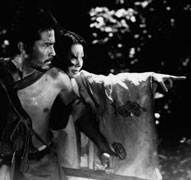
I watched Rashomon, the Great Movie Classic by The Legendary Director Akira Kurosawa again and didn’t like it any better the second time. I thought the story was weak and the acting bad. Visually, I thought it was very good and the sound was well-done, but for me that was not enough to carry it. So that’s my shallow review of a film that is considered by leading critics to be one of the great films of all time. What can I say?
Well, for one thing, Rashomon is one of those films that is more interesting to read about than to watch. The Wikipedia link above provides some great examples of how people can spend way too much time analyzing a piece of art. Kurosawa says that light and shadow were main characters in the film, but he says nothing about what their characterizations signified. One prominent critic finds that light represents the bad and shadow the good whereas another prominent critic finds just the opposite and both can make coherent arguments to support their position. Me? Cool use of light and shadow, is all I have to say about it. I don’t care what it means and would like to think that Kurosawa didn’t settle on some black and white meaning either. If he did, he at least had the artistic skill to leave it open to interpretation.
The story is told by four separate characters -- the murderer, the dead man, his wife, and a man who claims to have witnessed the crime, and none of the stories are the same. The plot is simple. A dead body is found. A criminal is apprehended. How did the dead man get that knife in his chest? That’s the mystery.
What does it mean? Well, duh, you may say, that story structure’s been done a hundred times. Like everything else, it has even been referenced in the Simpson’s (Marge: “you liked Rashomon.” Homer: “That’s how you remember it.”) Is it worth anything that Kurosawa did it first in Rashomon? Again, it’s interesting to read about, but watching the movie, who really cares?
Same thing with the cinematography, but I answer the question differently. Some of the techniques used in the filming of Rashomon were revolutionary. Is that worth anything? Again, it’s interesting to read about, but watching the movie, does it matter? Well, it doesn’t matter who did it first, but it matters that it’s done so well. The forest scenes where the camera is pointed directly into the sun are incredible. The rain scenes at the gate are insanely good as well. Rain doesn’t show up on film when you point a camera up against a grey sky, so they mixed black ink in the water so the rain would be visible. Interesting to read about, but when watching the movie, the visual element is all that matters, and the downpour at the gate is sublime cinematography.
It’s just the opposite with the story. If we analyze it like English majors, the story is great. It plumbs the emotional depths of human tragedy, at least from a male perspective, depicting one of our worst nightmares. A man and his wife are waylaid by a bandit. He is tied up and she is raped in front of him. Then he is murdered. We’re never sure what the sequence of events were, but each of the tellings is heartbreaking in its own way. In one, the woman enjoys the rape and asks the bandit to kill her husband. In another, the man wants nothing to do with her because she was raped. In the other, it’s a comedy of errors. Then the ending goes off on a totally different tangent and you can make of that what you will.
I’d skip the critics though, myself included, and decide for yourself. If you want to read something intelligent about it, I recommend going straight to the source. Before filming began, three of Kurosawa’s assistant directors came to see him. They had read the script many times without understanding it and asked him to explain it for them.
“Please read it again more carefully,” I told them. “If you read it diligently, you should be able to understand it because it was written with the intention of being comprehensible.” But they wouldn’t leave. “We believe we have read it carefully, and we still don’t understand it at all; that’s why we want you to explain it to us.” For their persistence I gave them this simple explanation:
Human beings are unable to be honest with themselves about themselves. They cannot talk about themselves without embellishing. This script portrays such human beings–the kind who cannot survive without lies to make them feel they are better people than they really are. It even shows this sinful need for flattering falsehood going beyond the grave—even the character who dies cannot give up his lies when he speaks to the living through a medium. Egoism is a sin the human being carries with him from birth; it is the most difficult to redeem. This film is like a strange picture scroll that is unrolled and displayed by the ego. You say that you can’t understand this script at all, but that is because the human heart itself is impossible to understand. If you focus on the impossibility of truly understanding human psychology and read the script one more time, I think you will grasp the point of it.
Yep.

|